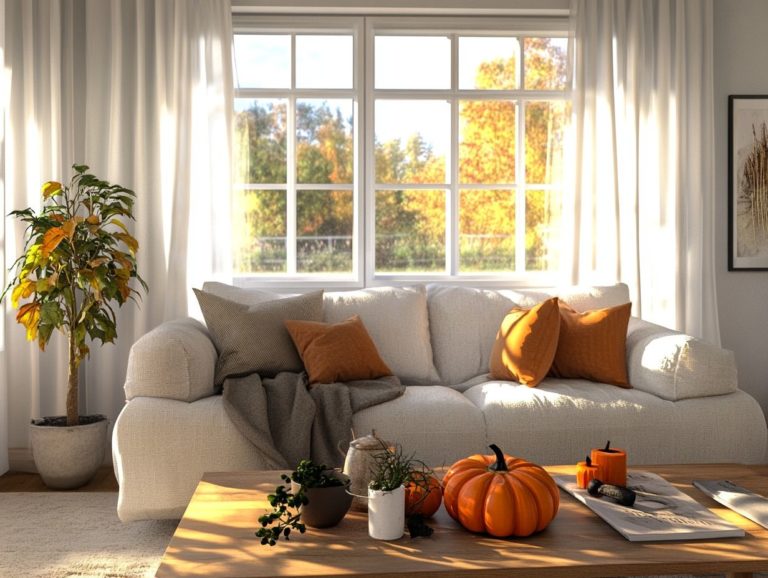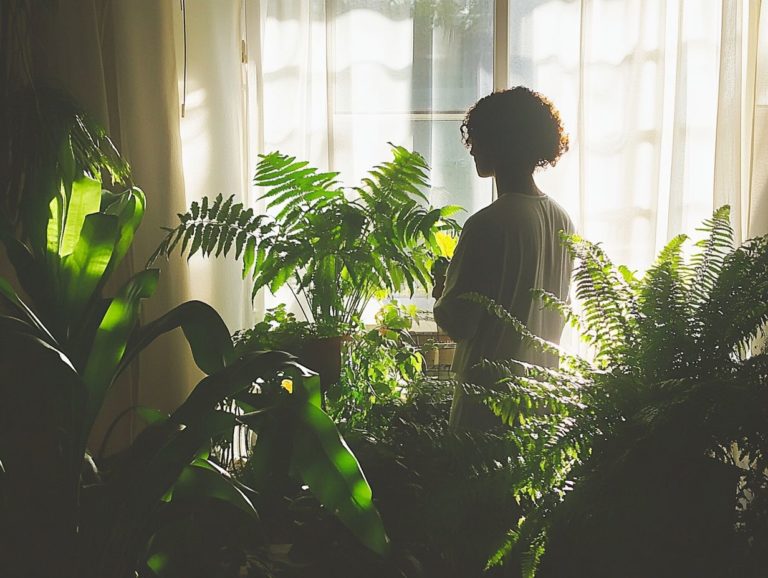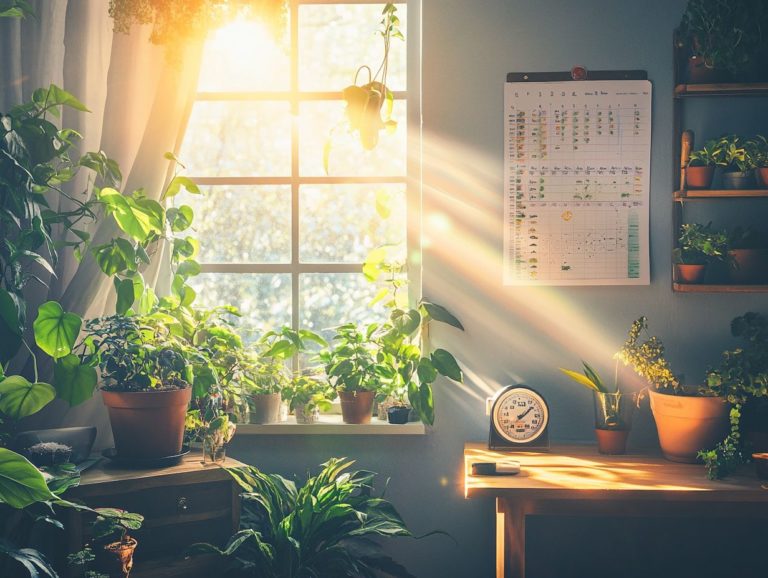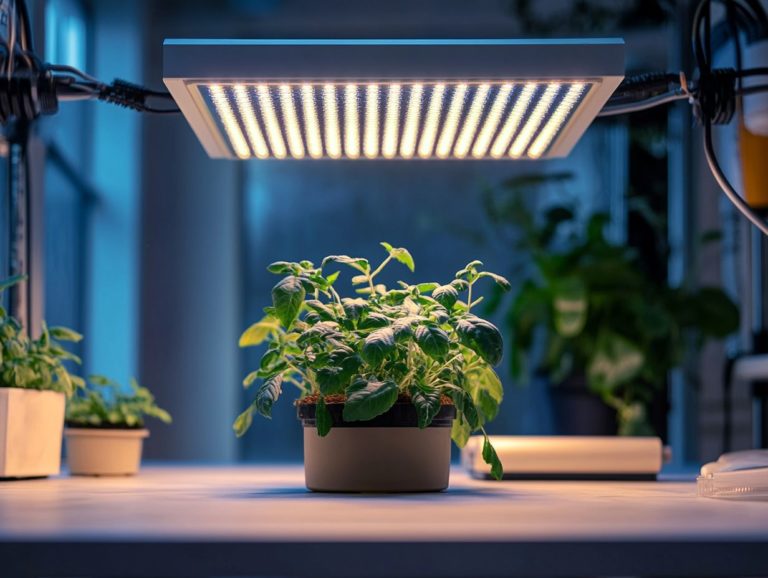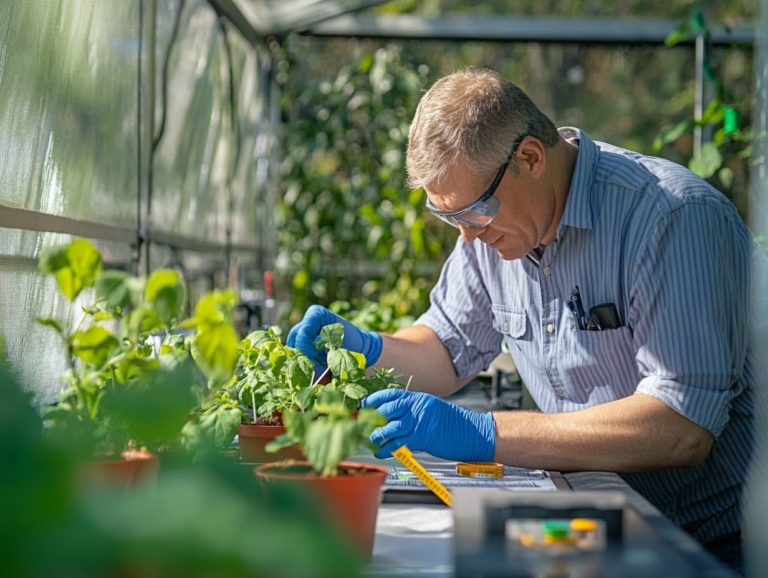The Importance of Light Duration for Plants
Light is essential for plant growth. It plays a crucial role in photosynthesis and flowering.
Understanding how light duration affects plant health can elevate your gardening success. This article covers the importance of light duration and its impact on various plant species.
You ll also find practical tips for ensuring your plants receive the right amount of light. Additionally, we ll explore other vital factors that contribute to their overall growth.
Explore these insights to unlock the secrets to thriving greenery!
Contents
- Key Takeaways:
- The Role of Light Duration in Plant Growth
- The Effects of Insufficient Light Duration
- Optimal Light Duration for Different Plants
- How to Ensure Adequate Light Duration for Plants
- Other Factors Affecting Plant Growth
- Frequently Asked Questions
- What is the importance of light duration for plants?
- How does light duration affect plant growth?
- What happens if plants do not receive enough light duration?
- Can plants receive too much light duration?
- How do different types of light affect plant growth?
- How can I determine the appropriate light duration for my plants?
Key Takeaways:
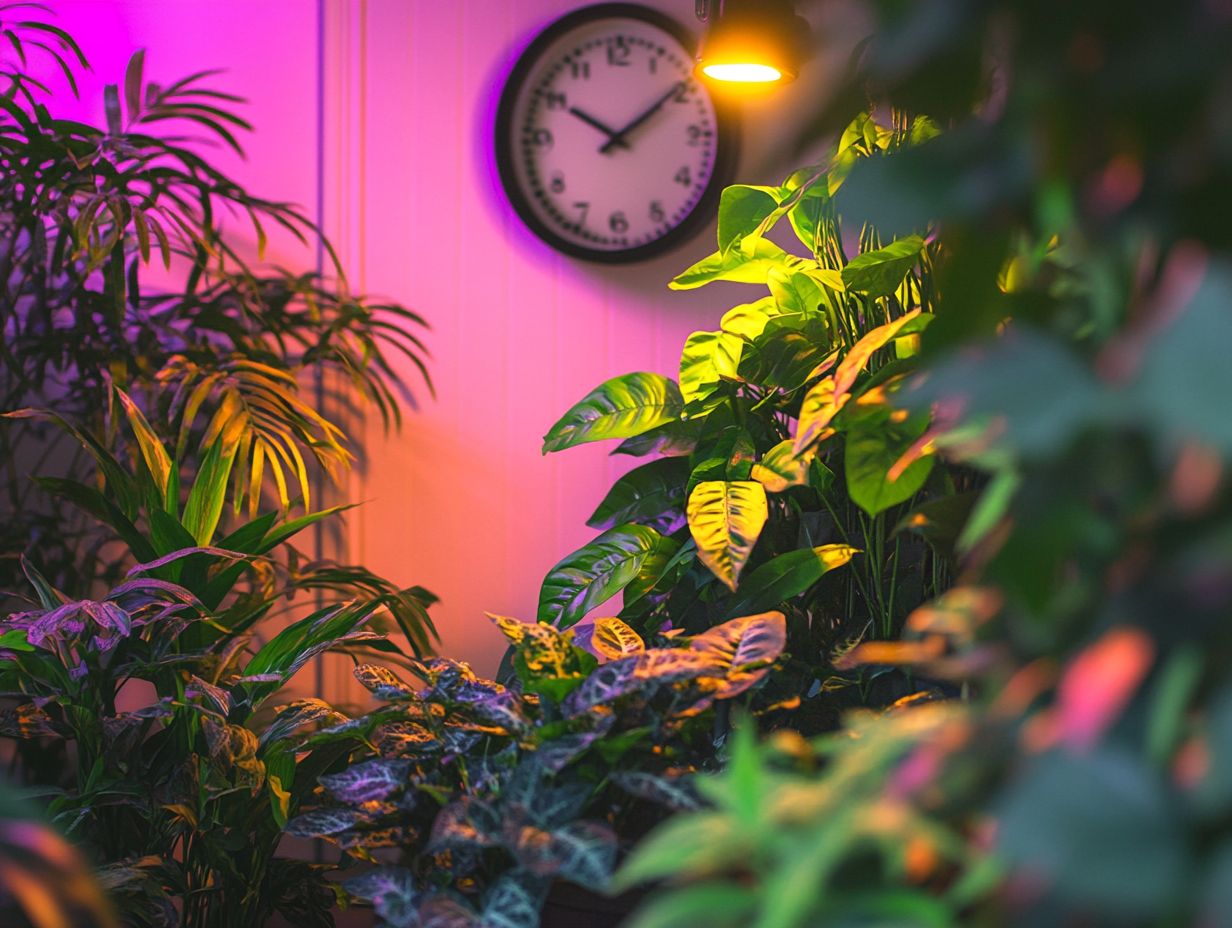
- Proper light duration is crucial for healthy plant growth.
- Inadequate light can stunt growth and harm overall health.
- Different plants have varying optimal light duration requirements, so it’s essential to research and adjust accordingly.
The Role of Light Duration in Plant Growth
Light duration is vital for your plants’ growth, affecting essential processes like photosynthesis and flowering behaviors. Whether you’re an indoor gardening enthusiast or a commercial grower, understanding how light influences plant growth is important.
Your plants harness light energy to turn carbon dioxide and water into glucose, which supports their health. The length of light exposure, especially when paired with high-quality grow lights and optimal conditions, directly impacts growth parameters like chlorophyll production.
Effectively managing light duration can boost the growth of your edible plants, including vegetables like tomatoes and herbs like basil.
The Effects of Insufficient Light Duration
Insufficient light duration can significantly undermine the health and growth of your plants. This can lead to stunted development and lackluster flowering.
Signs of Inadequate Light Exposure
Watch for stems stretching out as your plant reaches for light, often resulting in weak and spindly structures.
As an indoor gardener, you might also see leaf discoloration, where rich greens fade to yellow or brown, signaling a struggle for energy. A lack of adequate sunlight can lead to meager flowering, with blooms becoming sparse or nonexistent.
Keeping this balance is vital. Watch for other symptoms, such as stunted growth and curling leaves, as they may also emerge in low-light conditions.
Impact on Plant Health and Development
Don t let inadequate light harm your plants! Understand how it affects their growth. Insufficient light hampers essential growth processes, including photosynthesis and nutrient uptake.
When you deprive your plants of adequate lighting, they struggle to convert light into the energy needed for growth, resulting in stunted development and weakened health.
Inadequate lighting not only limits their chlorophyll production but also restricts their ability to absorb vital nutrients from the soil. Understanding the specific light requirements of different species is crucial for effective plant care.
For example, low-light plants require a different approach compared to their high-light counterparts. Assessing light conditions accurately is essential to promote optimal growth.
Optimal Light Duration for Different Plants

Determining the optimal light duration for your plants is crucial for maximizing their growth and ensuring their overall health. Long-day plants flourish under extended periods of sunlight, while short-day plants need shorter light durations to stimulate flowering.
By grasping how plants adapt to light, you can craft tailored lighting strategies that cater to their specific needs, ultimately enhancing their potential.
Factors to Consider
When figuring out the best light duration for your plants, several factors come into play. You need to consider the specific type of plant and its unique light needs.
You also need to account for the environmental cues surrounding the plant.
The growth stage of your plant is crucial for determining how much light it truly needs. For example, seedlings thrive under intense light conditions, while mature plants often prefer a bit less direct exposure.
Seasonal variations have a significant impact on light availability and temperature, which directly influence a plant’s photosynthesis (the process by which plants convert light into energy) and growth rate.
Each species has adapted to its native environment, developing specific light needs. Shade-loving varieties, for example, flourish under filtered sunlight, while sun-loving types crave bright, direct exposure.
Understanding this intricate interplay of growth stage, season, and species can provide you with valuable insights into optimal light management and watering regimes for any plant you choose to nurture.
Recommended Light Duration for Common Plants
For common edible plants like tomatoes, basil, cilantro, and strawberries, aim for a light duration of 12 to 16 hours per day to encourage healthy growth and flowering.
This duration is vital because it ensures these plants receive enough light energy for processes like photosynthesis, essential for their overall development.
Tomatoes thrive best with 14 to 16 hours of light, promoting a robust fruit set and increasing yield. Basil flourishes with around 12 to 14 hours, enhancing its flavor and essential oils.
Cilantro prefers slightly less light, ideally around 10 to 12 hours, to avoid the risk of premature bolting.
Strawberries need to soak in 12 to 15 hours of light to maximize both their flowering and fruiting stages, paving the way for a fruitful harvest! Understanding these specific light needs is crucial for a thriving garden!
How to Ensure Adequate Light Duration for Plants
Ensuring your plants receive the right duration of light begins with selecting the ideal light source, like high-quality grow lights. You’ll want to implement strategic placement and timing techniques to maximize their exposure, fostering optimal growth and vitality.
Choosing the Right Light Source
Choosing the right light source is essential for your indoor gardening success. Options like LED grow lights stand out, offering optimal light quality and energy efficiency tailored for various plant types.
If you prefer alternatives, fluorescent grow lights are another excellent choice. They provide a balanced spectrum of light that encourages healthy seedling development.
For those with larger setups, high-intensity discharge (HID) lights are often favored, delivering significant brightness that can dramatically enhance flowering and fruiting phases.
Each type of grow light presents its own light levels, which can differ in intensity and spectrum. Full-spectrum lights replicate natural sunlight, making them ideal for supporting plants at every growth stage.
By understanding the specific light quality and its impact on photosynthesis, you can ensure your plants thrive indoors, paving the way for a bountiful harvest and maximizing light exposure.
With the right light source, your plants will flourish, ensuring a vibrant indoor garden!
Proper Placement and Timing
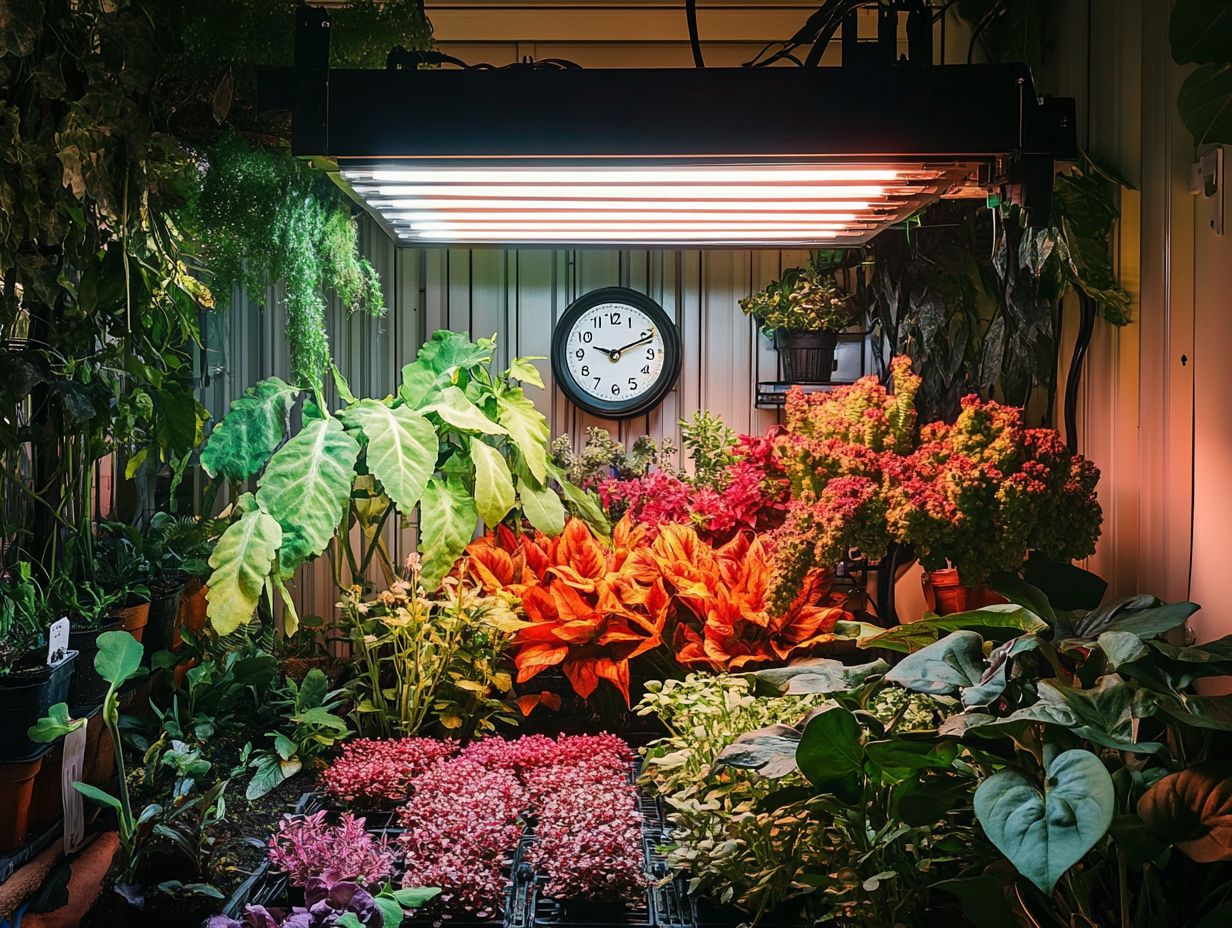
Proper placement and timing of light exposure are important for maximizing plant health. Different plants respond uniquely to light conditions based on their growth stages.
Understanding the specific needs of each plant species will guide your decisions for outdoor versus indoor environments. For instance, while some plants thrive in direct sunlight, basking in bright, unfiltered rays, others flourish under the gentle caress of filtered light or even in the cool shade.
Planting during the right season is crucial to ensure that the light intensity aligns with germination and growth cycles. Don t miss the daily and seasonal changes in light patterns! This allows you to position indoor plants near windows or strategically arrange them in outdoor gardens. This thoughtful approach will foster vibrant greenery throughout the year.
Other Factors Affecting Plant Growth
Beyond the duration of light, numerous other factors play a crucial role in plant growth. Nutrients, water availability, and a range of environmental conditions all contribute significantly to the overall health of your plants.
The Role of Nutrients and Water
The role of nutrients and water in plant health is very important, providing critical components needed for metabolic processes and fostering optimal growth conditions.
Establishing a balanced watering regime is key. Too much water can lead to root rot, while too little can hinder growth and vitality. Plants depend on a precise blend of major nutrients that they need in larger amounts like nitrogen, phosphorus, and potassium alongside micronutrients such as iron and magnesium to support vital functions like how plants make food and use energy.
Without this careful balance, growth can stagnate, leaving plants vulnerable to diseases and pests. By ensuring an adequate supply of both water and nutrients, you can create a thriving environment that encourages healthy development and robust yields.
Environmental Factors to Consider
Environmental factors like temperature, humidity, and soil conditions significantly influence plant growth. These elements shape how you observe plants adapting and responding to their surroundings.
These factors create a complex interplay that governs not only the physiological processes of photosynthesis and respiration but also affects nutrient absorption and metabolic rates. For instance, when temperatures rise, you might notice accelerated growth rates. However, if they surpass certain thresholds, plants may exhibit stress responses like wilting or stunted development.
Humidity levels are crucial, as they dictate transpiration rates. Excessive moisture can lead to fungal diseases, while insufficient humidity may prompt dehydration in plants. The health of the soil, rich with essential nutrients and balanced pH, serves as the foundation for robust growth, ultimately determining the life trajectory of plants and their capacity to thrive in diverse environments.
Understanding Light Duration for Different Growth Stages
Understanding light duration is essential for different growth stages of plants. Seedlings and mature plants have distinct requirements for light exposure to truly thrive.
The delicate transition from seedling to maturity requires tailored adjustments in light exposure. In the early stages, young plants rely on shorter light durations, which are crucial for promoting healthy development and minimizing stress. As they enter the vegetative phase, longer light intervals become vital for robust growth and effective chlorophyll production.
When they transition into the flowering stage, achieving the right balance of light and dark cycles is critical. This balance guides the flowering and fruiting processes. This variability emphasizes the significance of light adaptation strategies throughout each growth stage, ensuring that plants maintain optimal health and vitality as they mature.
Frequently Asked Questions
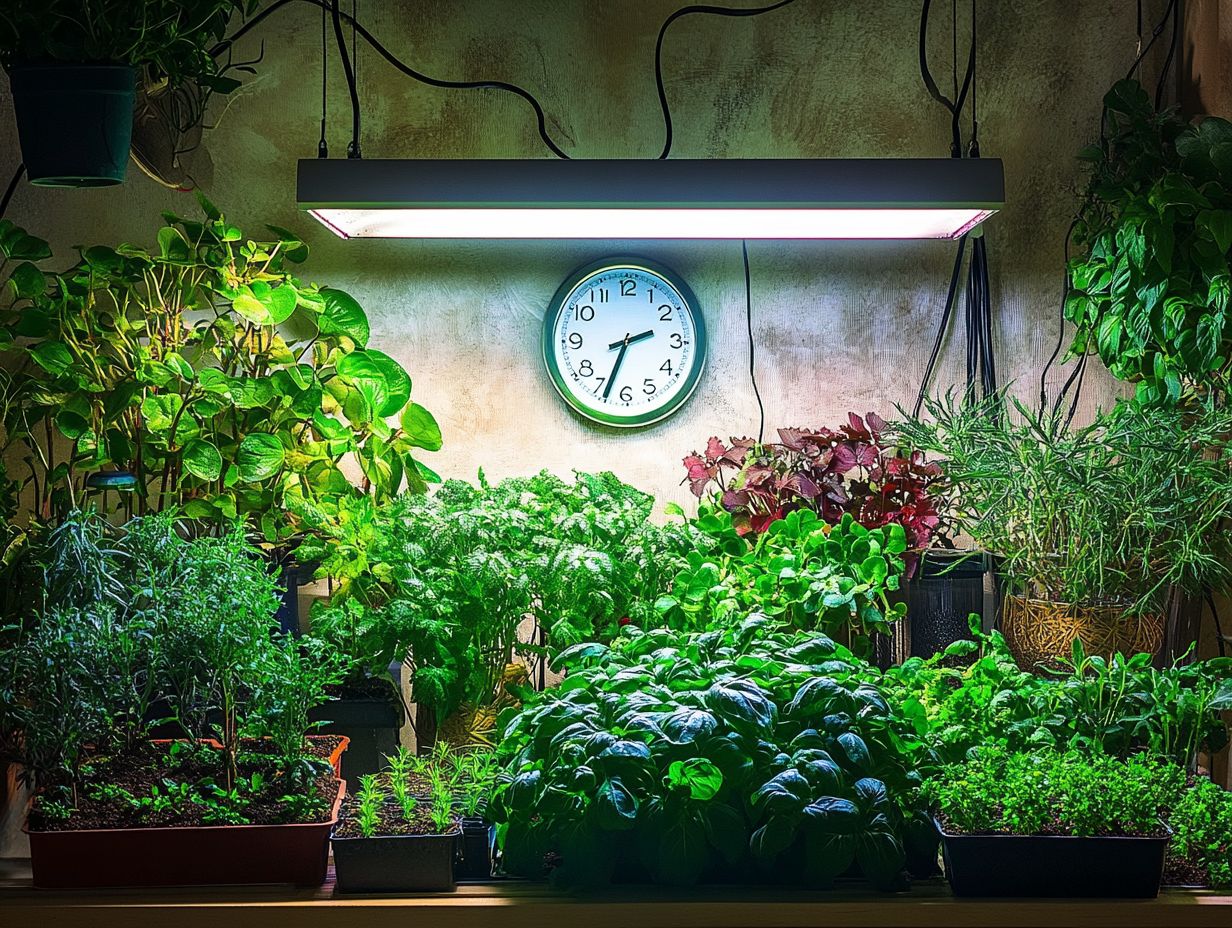
Have more questions? Don t hesitate to ask!
What is the importance of light duration for plants?
Light duration is how long plants get light. It’s vital for photosynthesis, a process that turns light into energy for growth.
How does light duration affect plant growth?
Light duration influences plant characteristics like leaf size, shape, and color. Insufficient light weakens plants, while too much can cause wilting.
What happens if plants do not receive enough light duration?
Without enough light, plants grow slowly and produce fewer flowers or fruits. They may also appear pale as they struggle to make chlorophyll, which gives them their green color.
Can plants receive too much light duration?
Yes, too much light can damage plants and even kill them! Excessive light causes cells to overheat, leading to wilting and leaf burn.
How do different types of light affect plant growth?
Natural sunlight and artificial grow lights affect plants differently. Sunlight offers a complete range of light, while artificial lights may only provide specific wavelengths.
How can I determine the appropriate light duration for my plants?
Your plants light needs depend on factors like type and growth stage. Research their specific needs and observe their growth to find the ideal light duration!

